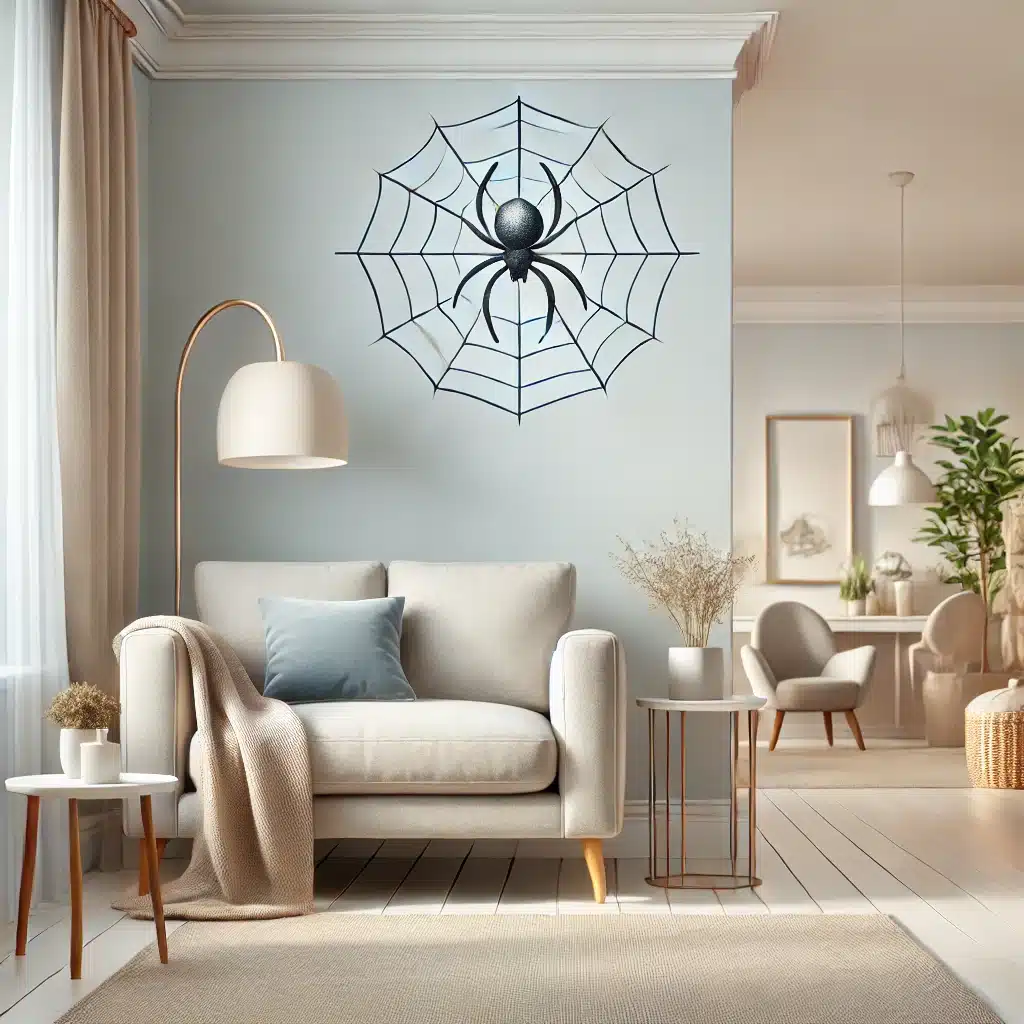Spiders are everywhere. For most people, they’re just a part of life at home. But sometimes, they can become a real problem—like when you find one crawling across your kitchen counter or hiding in your shoe. This guide is here to help you understand these eight-legged guests, how to keep them out, and what to do if they’ve already moved in.
Property managers should also pay attention. When tenants complain about spiders, it’s not just about comfort—spiders can also damage the reputation of a property. Keeping homes spider-free can make residents happier and less likely to move out.

No More Resident Complaints.
Understanding Spiders: What Are They and Why Are They Here?
To start, let’s get to know spiders a little better. Spiders are arachnids, which means they have eight legs and two body segments. Unlike insects, which have three body parts and six legs, spiders don’t have wings or antennae. They come in many shapes and sizes, and they all have fangs that can inject venom. This might sound scary, but most spiders are not harmful to humans. In fact, they often help by eating other pests like flies, mosquitoes, and even cockroaches.
But why are they in your home? There are a few reasons:
- Food: Spiders are hunters. They come inside looking for food, which usually means other insects. If you have a lot of bugs in your home, you’re likely to see spiders too. This is especially true in basements, attics, or any areas that don’t get a lot of foot traffic.
- Shelter: Spiders like dark, quiet places where they won’t be disturbed. Basements, crawl spaces, attics, garages, and storage areas are perfect hiding spots. These spaces offer a safe place to build webs and lay eggs. Some spiders, like cellar spiders, thrive in these environments because they prefer damp, cool conditions.
- Weather: Extreme weather conditions—whether too hot, cold, wet, or dry—can drive spiders indoors. They are looking for stable conditions to survive and continue catching prey.
For homeowners, knowing why spiders are inside can help in making the home less inviting to them. Property managers can use this information to understand tenant complaints better and take preventive measures, such as regular cleaning and maintenance in common areas like basements and storage spaces.
Identifying Common House Spiders
Not all spiders are created equal. Some are harmless, while others might need more attention. Here are some of the most common types you’re likely to find indoors:
- American House Spider: These are the ones you might find hanging out in corners or high up on walls. They are small (about the size of a nickel), brownish in color, and spin messy, tangled webs. These webs are often found in corners of rooms, windows, closets, and basements. These spiders are generally harmless and are actually good at keeping other insects under control. They are often mistaken for “cobweb spiders” due to the tangled nature of their webs.
- Cellar Spider (Daddy Long Legs): Cellar spiders are easy to identify because of their long, thin legs and tiny bodies. They often hang upside down in webs in damp areas like basements, cellars, and crawl spaces. They shake their webs when they feel threatened, which can make them look much bigger than they actually are. They’re not dangerous to humans, and their bite is not strong enough to pierce human skin.
- Jumping Spider: These spiders are small, with compact bodies and short legs. They’re often black or brown with white or colorful markings. Jumping spiders have excellent vision and are known for their jumping abilities, which they use to catch prey. You might find them in well-lit areas like windowsills, where they hunt during the day. They don’t spin webs to catch food; instead, they use silk to create draglines and jump to catch their prey.
- Wolf Spider: These are larger, hairy spiders that don’t spin webs. Instead, they roam around looking for food. They are usually found in basements or garages where they hunt at night. While they look scary due to their size, they are not aggressive and bites are rare. However, their bite can be painful and may cause mild symptoms.
Why does it matter to identify them? Knowing which spiders are common in your area helps determine the level of risk and the appropriate response. Homeowners may feel reassured knowing that most spiders found indoors are harmless. For property managers, identifying common spiders can help address tenant concerns and decide if professional pest control is necessary.
Black and White Spiders: What You Need to Know
Among the various types of spiders, black and white ones often catch people’s attention due to their striking appearance. One of the most common black and white spiders you might see indoors is the zebra jumping spider.
Zebra Jumping Spider:
Named for its black and white stripes that resemble a zebra, this spider is small, usually about 5-9 mm in length. It has a flat face with large, forward-facing eyes, which give it excellent vision. These spiders are harmless to humans and tend to be more curious than aggressive. They’re known for their jumping ability, which they use to pounce on prey rather than spinning webs. You’ll often see them near windows or doors where they hunt small insects.
Despite their small size, they can be intimidating because they move quickly and jump surprisingly far. But don’t worry—zebra jumping spiders are not dangerous to humans. In fact, they can be quite helpful by keeping other insect populations down. Homeowners might find them in bright areas where they hunt, while property managers may see them in shared or open spaces.
Why They Appear Indoors?
These spiders are attracted to areas with good lighting because it helps them spot prey. You may find them near windowsills or walls that get a lot of sun. Property managers should be aware that these spiders might appear more frequently in sunny common areas or places with lots of natural light.
Dealing with Black and White Spiders:
Since these spiders are not harmful, there’s usually no need for aggressive removal methods. Homeowners can gently capture and release them outdoors, or use a vacuum cleaner to remove them if they’re uncomfortable handling them directly. For property managers, regularly dusting and cleaning well-lit areas can help keep these spiders from settling in.
Brown Recluse Spiders: A Hidden Danger
Brown recluse spiders are one of the spiders that people fear most—and for good reason. These spiders are known for their venomous bite, which can cause serious skin problems. They are small, usually light to dark brown, and have a distinct violin-shaped marking on their back. They are sometimes called “fiddleback” spiders because of this marking.
Brown recluse spiders are mostly found in the Midwest and Southern United States, but they can travel to other areas through shipments or moving boxes. They are most active at night and prefer dark, quiet spaces where they won’t be disturbed, such as basements, attics, closets, and garages. They also hide in piles of clothes, shoes, cardboard boxes, or old furniture.
Why Are Brown Recluse Spiders a Problem?
Unlike many other spiders, the brown recluse can be a real danger to humans. When they feel threatened or get trapped against the skin, they might bite. While their bites are not always dangerous, they can sometimes cause severe reactions, including intense pain, itching, and even tissue damage. The bite often starts as a small red bump but can develop into a blister or open sore that gets bigger over time. In some cases, it might take weeks or even months for the wound to heal.
For homeowners, having brown recluse spiders in the home is a cause for concern. People with young children, pets, or anyone with weakened immune systems need to be especially cautious. Property managers also need to be aware of these spiders since a single sighting or bite can lead to complaints or even lawsuits.
How to Identify a Brown Recluse Infestation:
Spotting a brown recluse isn’t always easy. These spiders are reclusive by nature and often hide in areas that are out of sight. Here are some signs that you might have a problem:
- Spider Sightings: Seeing a brown recluse spider, especially in areas where they are common, is a strong indication.
- Webs and Sheds: Look for irregular, messy webs near the ground, in corners, or around storage areas. Also, keep an eye out for shed skins, as brown recluses molt several times during their life.
- Bites: If unexplained bites appear on your skin, especially ones that don’t heal or seem to get worse, consider the possibility of a brown recluse spider.
Prevention and Control Tips for Brown Recluse Spiders:
If you live in an area where brown recluse spiders are common, you’ll want to take steps to keep them out of your home:
- Seal Entry Points: Close up cracks and gaps in your home’s foundation, walls, and around doors and windows.
- Reduce Clutter: Spiders love cluttered spaces where they can hide. Keep your home tidy, especially in areas like basements, attics, and closets.
- Use Sticky Traps: Place sticky traps in areas where you suspect spider activity. This can help catch spiders and give you an idea of where they are coming from.
- Consider Professional Help: If you suspect a serious infestation, call a pest control professional who knows how to handle brown recluse spiders safely.
The Most Dangerous Spiders in California
California is home to several species of spiders, but two stand out as particularly concerning: the black widow and the brown recluse.
- Black Widow Spider: Known for their shiny black bodies and red hourglass shape on their abdomen, black widow spiders are among the most feared spiders in California. They prefer dark, undisturbed areas like woodpiles, sheds, and garages. Black widows are not aggressive, but their bites can be dangerous, especially for small children, the elderly, or those with weakened immune systems. The bite can cause muscle pain, cramping, sweating, and other severe symptoms that require medical attention.
- Brown Recluse Spider: As mentioned earlier, brown recluses are known for their harmful bites. Though less common in California than in the Midwest, they can still be found, particularly in areas where they might have traveled via shipments or luggage.
Other Spiders to Be Aware Of:
- Desert Recluse: Another relative of the brown recluse, this spider is mainly found in California’s desert regions. It has similar behaviors and risks as the brown recluse but tends to stay in outdoor areas.
- Wolf Spiders: Large and hairy, wolf spiders might look intimidating, but they are not considered dangerous. They are ground hunters and can occasionally wander indoors, especially in search of prey or during colder months.
Protecting Yourself from Dangerous Spiders in California:
Homeowners should be vigilant about keeping areas clean and free from clutter, especially garages, basements, and sheds. Wear gloves when reaching into dark or cluttered areas and shake out shoes or clothing that has been left on the floor. Property managers should ensure that common areas, storage rooms, and garages are well-maintained and cleaned regularly to avoid attracting these pests.
Small Spiders That Look Like Crabs
Have you ever noticed a tiny spider that looks like it has crab-like legs or moves in a sideways manner, like a crab? You might have come across a crab spider. Crab spiders get their name from their crab-like appearance and behavior. They are small, with flat, wide bodies, and often have legs that extend out to the sides, giving them a crab-like stance. They can come in a variety of colors, including white, yellow, green, and brown, which helps them camouflage with their surroundings.
Where Do You Find Crab Spiders?
Crab spiders are usually found outdoors, often on flowers or plants where they wait to ambush their prey. However, they can sometimes find their way indoors, especially in areas with lots of plants or where doors and windows are frequently left open.
Are Crab Spiders Dangerous?
Generally, crab spiders are not harmful to humans. They do not have venom that is dangerous to people, and they are unlikely to bite unless they are handled roughly. In fact, crab spiders can be beneficial because they help control pests like flies and small insects.
How to Deal with Crab Spiders:
For homeowners, if you find a crab spider indoors, you can usually just guide it back outside. If you have an ongoing problem, check for openings around doors and windows where they might be coming in. Property managers should ensure that window screens are intact and that there are no gaps under doors that could allow these spiders to enter.
Why You Find Spiders in the Basement
Basements are one of the most common places to find spiders, and it’s not hard to understand why. Basements are often dark, quiet, and rarely disturbed—perfect hiding spots for spiders.
Reasons Spiders Love Basements:
- Darkness and Dampness: Many spiders, like cellar spiders, prefer cool, dark environments. Basements provide a perfect climate for them to live and hunt.
- Food Sources: Basements often attract other pests, like insects, which are a food source for spiders. Where there are bugs, there will often be spiders.
- Clutter and Storage: Basements are often used for storing boxes, old clothes, and unused furniture. These items create perfect hiding spots for spiders to spin their webs and lay eggs.
How to Get Rid of Spiders in Your Basement:
- Declutter Regularly: Get rid of old boxes, newspapers, and other items that might provide hiding spots for spiders.
- Seal Cracks and Gaps: Spiders can enter through tiny cracks in the foundation, walls, or around windows. Sealing these openings can prevent them from getting inside.
- Dehumidify: Use a dehumidifier to reduce the moisture level in your basement. Spiders and other pests are less likely to stay in dry areas.
- Use Spider Repellents: Natural repellents like peppermint oil or vinegar sprays can be effective at keeping spiders away. Spray these around windows, doors, and any cracks where spiders might enter.
- Consider Professional Pest Control: If spiders continue to be a problem, especially dangerous ones like brown recluses, professional pest control services might be the best option. They can assess the situation and provide targeted treatments to keep spiders out.
Keeping Spiders Away from Your Patio Furniture
Spending time on the patio should be relaxing, but nothing spoils the mood faster than finding spiders crawling on your furniture or spinning webs between your chairs. Spiders are drawn to outdoor furniture because it provides great places to build their webs, hide from predators, and catch prey. Here’s how you can keep spiders off your patio furniture and enjoy your outdoor space without worry.
Why Do Spiders Love Patio Furniture?
Outdoor furniture, especially if it’s near plants or trees, can be a prime location for spiders. The furniture provides ideal places to build webs or nests, while the nearby vegetation offers a steady supply of insects for food. Cushions, hollow furniture legs, and crevices are perfect hiding spots for spiders.
Tips to Keep Spiders Away from Your Patio Furniture:
- Clean Regularly: Regular cleaning is the simplest way to keep spiders away. Shake out cushions and vacuum or wipe down furniture to remove any webs or eggs. Spiders don’t like to settle in areas that are disturbed often.
- Move Furniture Away from Walls or Plants: Spiders are more likely to come onto your patio if there are bushes, trees, or other vegetation nearby. Try to keep your furniture away from these areas to reduce the chances of spiders finding their way onto it.
- Use Spider Repellents: Natural repellents like peppermint oil, citrus oil, or eucalyptus oil can be very effective. Simply mix a few drops of the essential oil with water in a spray bottle and spray your furniture regularly. Spiders dislike these scents and will avoid areas treated with them.
- Consider Covers: Use furniture covers when your patio furniture is not in use. Covers help keep spiders from nesting in the crevices of your chairs or under cushions. Make sure to check and shake out the covers regularly.
- Reduce Lighting: Outdoor lights attract insects, which in turn attract spiders. Try using yellow or sodium vapor light bulbs, which are less attractive to insects. You can also consider using motion-sensor lights that only come on when needed.
- Seal Cracks and Openings: If you have cracks in your patio or around doors and windows leading to your outdoor area, seal them up. This prevents spiders from sneaking inside or onto your furniture.
- Trim Nearby Plants: Keep bushes, trees, and other plants trimmed back from your patio. This reduces the number of insects near your patio and makes it less attractive to spiders looking for food.
By taking these steps, you can create an outdoor environment that is less welcoming to spiders, helping you to enjoy your patio furniture without unwanted eight-legged guests.
Natural Methods for Spider Control
Many people prefer natural methods to control spiders in their homes because they are safer for children, pets, and the environment. Here are some of the most effective natural methods you can use to keep spiders out.
Using Essential Oils
Spiders have a strong sense of smell, and they dislike certain scents. Essential oils like peppermint, lavender, tea tree, eucalyptus, and citrus are known to repel spiders.
- How to Use: Mix 10-15 drops of essential oil with water in a spray bottle. Shake well and spray around windows, doors, and any other places where spiders are likely to enter your home. You can also soak cotton balls in the oil and place them in corners, closets, or under furniture.
- Benefits: Essential oils are safe, non-toxic, and leave a pleasant smell. They can also deter other pests like ants and mosquitoes.
Vinegar Spray
White vinegar contains acetic acid, which is harmful to spiders. They avoid areas treated with vinegar.
- How to Use: Mix equal parts of white vinegar and water in a spray bottle. Spray in areas where you see spiders or where they might enter, like window sills, door frames, and baseboards.
- Benefits: Vinegar is cheap, readily available, and effective at repelling spiders. However, it does have a strong odor that some people may find unpleasant.
Diatomaceous Earth (DE)
Diatomaceous earth is a powder made from crushed fossils of aquatic organisms. It is harmless to humans and pets but deadly to insects and spiders.
- How to Use: Sprinkle DE around entry points, under cabinets, or anywhere you suspect spider activity. When spiders crawl over it, the DE damages their exoskeletons, causing them to dehydrate and die.
- Benefits: DE is natural, safe, and can also kill other pests like ants, fleas, and bed bugs.
Chestnuts and Citrus Peels
There are claims that placing chestnuts or citrus peels around your home can repel spiders. It’s believed that spiders dislike the smell of these items.
- How to Use: Place fresh chestnuts or citrus peels on windowsills, in corners, or near doors. Replace them regularly to keep the scent strong.
- Benefits: This method is simple, inexpensive, and can be combined with other natural methods.
Maintaining a Clean Environment
Spiders love clutter because it provides great hiding spots. Keeping your home clean and free of debris is one of the best ways to prevent spider infestations.
- How to Use: Regularly vacuum and dust your home, especially in corners, under furniture, and in basements or attics. Store items in sealed plastic bins rather than cardboard boxes, which can attract spiders.
- Benefits: A clean home is less attractive to spiders and other pests. Plus, it helps you spot and remove any spiders or webs that do appear.
By using these natural methods, homeowners can effectively manage spider populations without relying on harsh chemicals.
Chemical Solutions for Spider Control
For some, natural methods might not be enough, especially if you have a large infestation or particularly dangerous spiders like the brown recluse or black widow. In these cases, chemical solutions can provide more immediate and lasting results.
Insecticide Sprays
Many over-the-counter insecticide sprays are designed to kill spiders on contact and provide residual protection to prevent them from returning.
- How to Use: Apply insecticide sprays in areas where spiders are commonly found, such as corners, baseboards, and entry points. Make sure to follow all safety instructions on the label, especially when using them in homes with children or pets.
- Benefits: Insecticide sprays are quick and effective. They can kill spiders on contact and leave a residue that continues to repel spiders for weeks.
Spider Repellent Sprays
Some sprays are specifically designed to repel spiders rather than kill them. These products often contain natural ingredients like essential oils or chemicals that spiders dislike.
- How to Use: Spray these repellents around windows, doors, vents, and other potential entry points. They can also be applied in areas where spiders are known to build webs.
- Benefits: Repellent sprays help to keep spiders out without the need to kill them, which can be preferable for those who want to control spider populations humanely.
Glue Traps
Sticky traps can be placed around the home to catch spiders and other insects. They are useful for monitoring spider activity and identifying areas of infestation.
- How to Use: Place glue traps in areas where spiders are frequently seen, such as basements, closets, and garages. Check traps regularly and replace them as needed.
- Benefits: Glue traps are safe to use around children and pets (when placed out of reach) and provide a non-toxic way to reduce spider populations.
Fumigation
In extreme cases where there is a large infestation or dangerous spiders like brown recluses, professional fumigation may be required. This involves using gas to fill the home and kill all spiders and other pests.
- How to Use: Fumigation must be done by a licensed pest control professional. Homeowners will need to leave the property for a period of time while the process is carried out.
- Benefits: Fumigation can eliminate all spiders and other pests in a single treatment, making it ideal for severe infestations.
Safety Tips for Using Chemicals:
- Always read and follow label instructions carefully.
- Keep chemicals out of reach of children and pets.
- Wear protective clothing, such as gloves and masks, when applying insecticides.
- Ventilate the area well after applying sprays or using chemical treatments.
Professional Pest Control Services
There comes a time when it makes sense to call in the professionals. If you’ve tried natural and chemical methods but still see spiders, or if you’re dealing with a potentially dangerous species, it might be time to consider professional pest control services.
When to Call a Professional:
- Persistent Infestations: If spiders keep coming back despite your efforts, a professional can help identify the source of the problem and provide targeted treatments.
- Dangerous Spiders: If you suspect you have brown recluse, black widow, or other venomous spiders, professional help is highly recommended.
- Large Homes or Properties: If you’re a property manager dealing with multiple units or a large property, professional pest control services can save you time and ensure all areas are treated thoroughly.
- Tenant Complaints: For property managers, repeated tenant complaints about spiders can affect your reputation. Professional services can help resolve the issue quickly and keep residents happy.
What to Expect from Professional Services:
- Inspection: A pest control professional will inspect your property to identify the types of spiders present, their entry points, and any signs of infestation.
- Treatment Plan: Based on the inspection, they will develop a treatment plan tailored to your specific situation. This could involve a combination of sprays, baits, traps, and exclusion techniques.
- Follow-Up: Many pest control companies offer follow-up visits to ensure the problem is resolved and to provide ongoing prevention.
Costs and Benefits:
While professional pest control services come with a cost, they often provide a more thorough and effective solution than DIY methods. The peace of mind that comes from knowing your home is spider-free can be worth the investment, especially for those with children, pets, or health concerns.
Pest-Proofing Your Home Against Spiders
The best way to deal with spiders is to prevent them from coming inside in the first place. Pest-proofing your home means making it as unwelcoming to spiders as possible.
Sealing Entry Points:
- Doors and Windows: Install door sweeps on all exterior doors and repair damaged screens. Seal gaps around windows with weather stripping.
- Cracks and Crevices: Use caulk or foam sealant to fill cracks in the foundation, walls, and around pipes and vents.
- Utility Lines: Check areas where utility lines enter your home and seal any gaps.
Reducing Food Sources:
- Clean Up Crumbs: Spiders are attracted to insects, which are attracted to food. Keep your home clean by wiping down surfaces, sweeping floors, and storing food in sealed containers.
- Fix Leaks: Repair any leaks that could attract insects, which in turn will attract spiders.
Regular Maintenance and Cleaning:
- Declutter: Keep your home clutter-free, especially in storage areas like basements, garages, and attics. Store items in plastic bins with tight-fitting lids.
- Vacuum Regularly: Vacuuming is one of the most effective ways to remove spiders, eggs, and webs. Pay special attention to corners, baseboards, and under furniture.
Outdoor Maintenance:
- Trim Vegetation: Keep trees, shrubs, and plants trimmed back from your home. This reduces the number of insects near your home and makes it harder for spiders to find their way inside.
- Remove Webs: Regularly knock down spider webs around your home’s exterior, eaves, and windows.
Using Pest Share Services for Comprehensive Protection:
For both homeowners and property managers, Pest Share offers a reliable solution to pest problems, including spider control. By incorporating Pest Share’s services, you can ensure that your property is always protected from pests, keeping everyone happy and safe.
A Spider-Free Home for All
Spiders are a natural part of life, but that doesn’t mean they have to be a part of your home. With the right knowledge and strategies, you can keep your home spider-free, whether you’re dealing with harmless house spiders or more dangerous types like the brown recluse. Use a combination of natural methods, chemical solutions, and professional services when needed, and always keep your home clean and well-maintained. Remember, the goal is not just to eliminate spiders, but to make your home less inviting to them in the first place.







